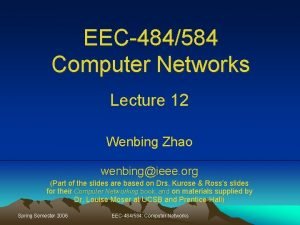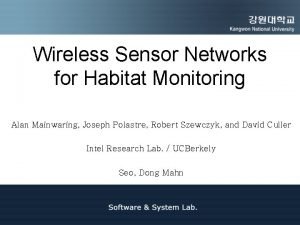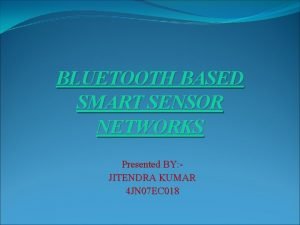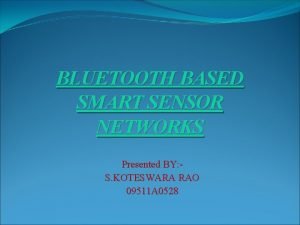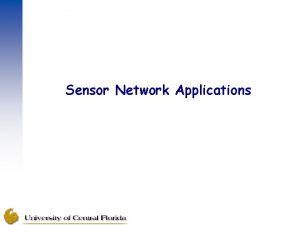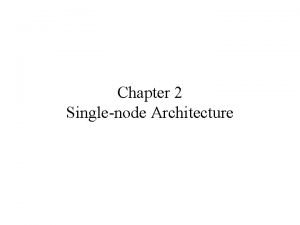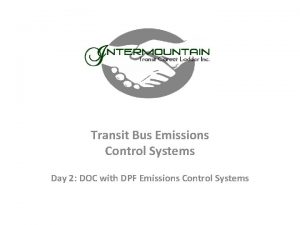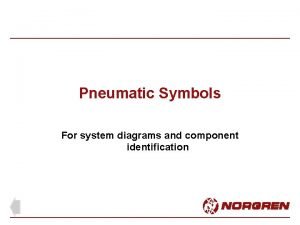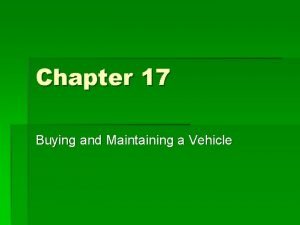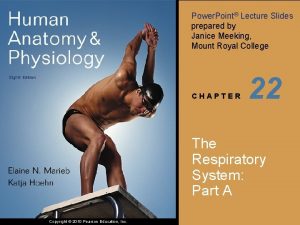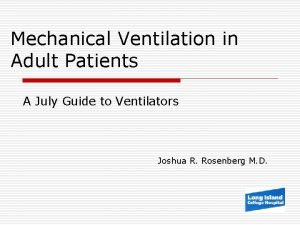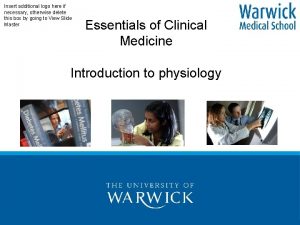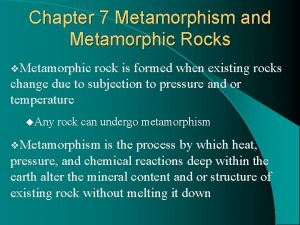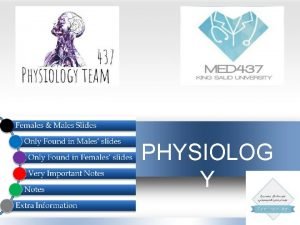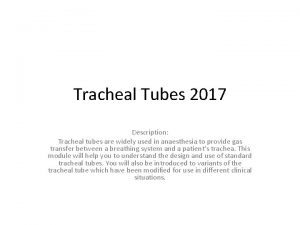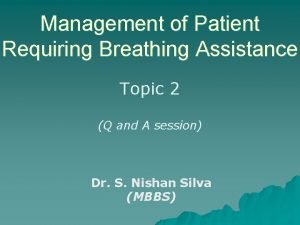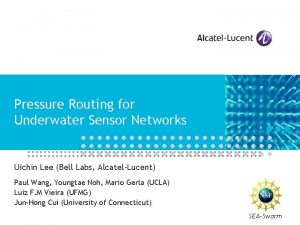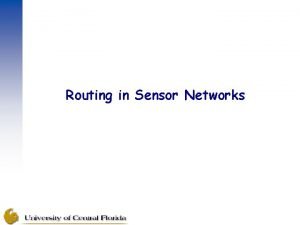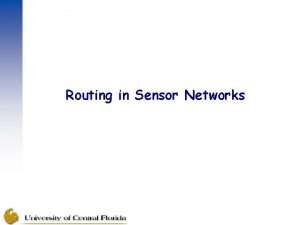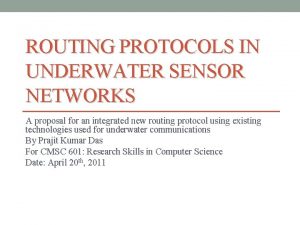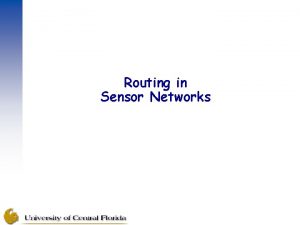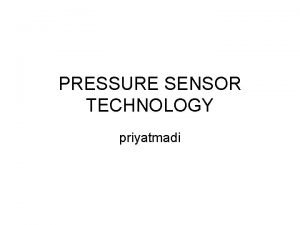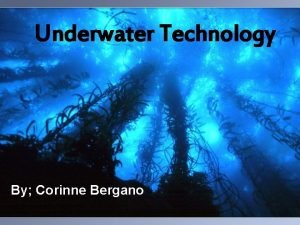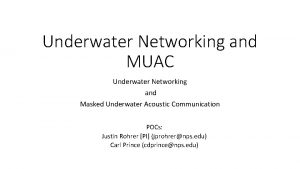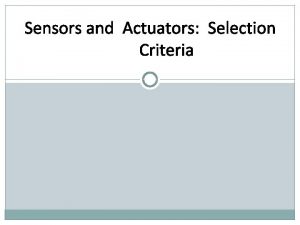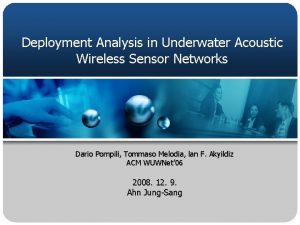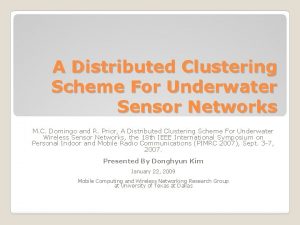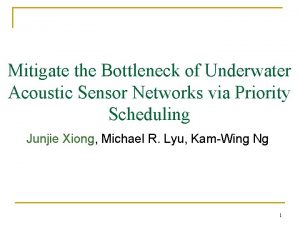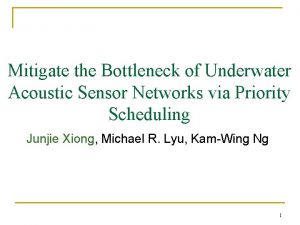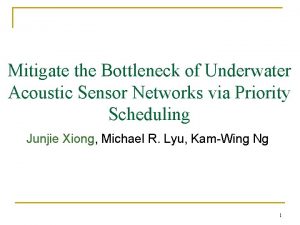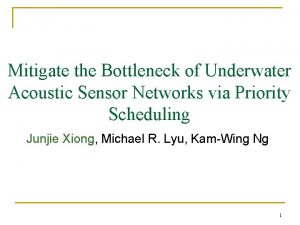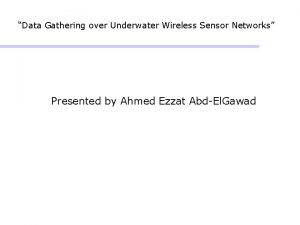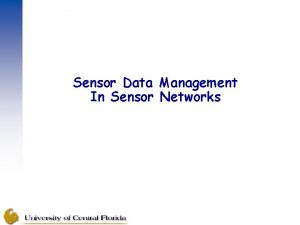Pressure Routing for Underwater Sensor Networks SEASwarm Sensor
























- Slides: 24

Pressure Routing for Underwater Sensor Networks

SEA-Swarm (Sensor Equipped Aquatic Swarm) Example: UCSD Drogues Acoustic Communications Acoustic modem Pressure (depth) sensor Depth control device + Other sensors Pictures from: http: //jaffeweb. ucsd. edu/node/81 SEA Swarm architecture

Problems • SEA-Swarm challenges: – Acoustic comms: energy hungry, low bandwidth, long propagation delay – Nodes mobility due to water movement • Ground sensor routing protocols do not work well in underwater – High protocol overheads, e. g. , route discovery and maintenance • 3 D geographical routing (stateless, localization) has the following limitations: – Requires distributed underwater localization – Efficient recovery from a local maximum

Hydro. Cast: Underwater Pressure Routing error • Hydro. Cast: 1 D geographic anycast routing (to any one of the sonobuoys) – Using measured pressure level (or depth) from on-board pressure sensor – A packet is forwarded to a node that is closest to the water surface (or the lowest depth node in one’s neighbors) error distance ? Local max Advance Zone S Packet drops due to channel errors: 2 requires a robust forwarding mechanism Stuck at local maximum: requires a recovery mechanism

Opportunistic Routing • Handle channel errors by opportunistic routing: – Any node that has received the packet correctly (called forwarding set) can forward the packet to next hop • Existing opportunistic routing protocols: – Anypath Routing based on extended link-state algorithms • Ex. OR, Least Cost Opportunistic Routing (LCOR) • Not suitable for SEA-Swarm due to overhead (network-wide link state flooding) – Geo-Opportunistic Routing (GOR) based on stateless position-based algorithms • Geographic Random Forwarding (Ge. Ra. F), Contention Based Forwarding (CBF), Focused Beam Routing (FBR)

Geo-Opportunistic Routing (GOR) A packet is broadcast, each node determines its own priority based on its distance to the surface, high priority node’s transmission suppresses low priority nodes’ transmissions Surface 1 2 Advance Zone 3 S Node 3 fails to suppress its transmission: Need to carefully select a forwarding set that is hidden-terminal free

Geo-Opportunistic Routing (GOR) Forwarding set selection heuristic: geometric shape facing toward the destination Example: fan shape (FBR) or Reuleaux triangle (CBF) Surface Expected progress: Original: d(1)*p(1) New: d(1)*p(1) + d(2)*(1 -p(1))*p(2) 1 2 d(1) d(2) Advance Zone S d(i): node i’s progress (meter) p(i): prob. node i successfully receives a packet d(i)*p(i) = normalized progress Problem: this selection heuristic often fails to maximize progress

Hydro. Cast: Forwarding Set Selection (Clustering) 1. find node i that has the greatest normalized progress: d(i)*p(i) 2. include all nodes whose distance from node i is in βR (R tx range, β=0. 5) 3. if other neighbors are left, clustering proceeds starting from the remaining node with the highest normalized progress (i. e. , repeat step 1 and 2). 4. each cluster is then expanded by including nodes whose distance to any node in the cluster is smaller than R (node can hear one another) 5. select the cluster with the greatest expected progress as a forwarding set Surface Cluster A: 1 2 Expected Progress Cluster B: 3 4 Advance Zone Expected Progress: Cluster A: d(1)*p(1) + d(2)*(1 -p(1))*p(2) + d(3)*(1 -p(1))(1 -p(2))*p(3) Cluster B: d(3)*p(3) + d(4)*(1 -p(3))*p(4) d(i): node i’s progress (meter) p(i): prob. node i successfully receives a packet d(i)*p(i) = normalized progress

Hydro. Cast: Recovery Mode – Limitation of random walks in SEA-Swarm • Due to vertical routing, any nodes below the local max need to repeatedly perform random walks – Hydro. Cast: local lower-depth-first recovery (stateful approach) • Each local max builds an escape path to a node whose depth is lower; after one or several path segments that go through local maxima, we can switch back to greedy mode Recovery path A node knows whether it is in local max or not

Hydro. Cast: Recovery Mode • 2 D void floor surface flooding for recovery path discovery – Only nodes on the envelope (surface) participate in path discovery • Surface node detection – Non-surface node: if a node is completely surrounded by its neighboring nodes • Every direction has a dominating triangle – Detection: tetrahedralization with length constraint (tx range) intractable • Detection heuristic: pick k random directions; for each direction, check if there’s a dominating triangle; otherwise, a node is a surface node SEA-swarm’s floor surface X’s dominating triangle in direction D 1 X: Non-surface node

Simulations Setup – Qual. Net 3. 9. 5 enhanced with an acoustic channel model • Urick’s u/w path loss model: A(d, f) = dka(f)d where distance d, freq f, absorption a(f) • Rayleigh fading to model small scale fading – Acoustic modem: • Modulation method: BPSK (Binary Phase Shift Keying) • Tx power: 105 d. B re u. Pa, data rate: 50 Kbps, tx range: ~250 m – Nodes are randomly deployed in an area of “ 1000 m*1000 m” • Mobility model: 3 D version of Meandering Current Mobility (MCM)

Results: Forwarding Set Selection Expected Progress (m) • Hydro. Cast’s clustering is very close to the optimal solution • Vertical cone based approach (CBR, FBR) performs poorly – When density is low, its performance is even lower than NADV: max d(i)*p(i) max normalized progress NADV 1 Con-Vert Optimal Clustering Cone-Vert NADV Number of nodes in the advance zone 2 Clustering Cone-Vert 3 4 Advance zone

Results: Hydro. Cast Performance • Hydro. Cast w/ SD-R performs the best – SD (surface detection): SD-R (our heuristic), SD-A (angle-based, 60˚) • DBR performs better than Hydro. Cast w/o recovery (due to multi-path delivery) SD-A Packet delivery ratio 60˚ DBR Hydro. Cast w/o recovery Hydro. Cast w/ Recovery (SD-R) Hydro. Cast w/ Recovery (SD-A) Depth Based Routing (DBR) Hydro. Cast w/o Recovery Number of nodes Forwarding set 1 2 3 DBR: depth-based threshold 4 5 Advance zone Depth Based Routing: DBR

Conclusion • Hydraulic pressure-based anycast routing allows report timecritical sensor data to the sonobuoys on the sea level using acoustic multi-hopping • Hydro. Cast: – Novel opportunistic routing mechanism to select the subset of forwarders that maximizes greedy progress yet limits co-channel interference – Efficient dead-end recovery mechanism that outperforms recently proposed approaches (e. g. , random walk, 3 D flooding) • Research directions: – Mobility prediction (using low power sensors) – Dynamic topology control/maintenance • Mechanical (depth control/replenishing) + electronic (transmission power)

Opti. Mo. S: Optimal Sensing for Mobile Sensors

Introduction • Sensor coverage maximization and energy cost minimization are basic needs in monitoring • Static WSN – Inflexible for monitoring location-varying environment – Deploying more static sensors are expensive • Mobile Sensors – Open. Sense • Sensors deployed on Buses, Trams.

Open. Sense • Optimal sensor placement – To build the optimal mobile sensing for each individual bus line – To build global optimal sensing, which provides optimal sensing for all bus lines, where individual sensing on one bus line should consider nearby bus lines.

Opti. Mo. S • An optimal mobile sensing for achieving appropriate tradeoff between “sensor coverage maximization” and “energy cost minimization”. – Two-Tier Sensing Platforms: Segmentation and Sampling – Optimal sensing for one bus line (a single mobile node), or multiple bus lines – Optimal co-sensing among different sensors, e. g. , CO 2, NO 2 …

Model-Driven Segmentation of Mobile Sensing Problem Statement of Segmentation • Initial Sensor Readings – Sensor reading records – Each record with time, location, measurements • Data-driven Modeling – Various models: linear, SVM regression, etc. – Model errors RSS – Residual Sum of Square • Optimal Segmentation

Segmentation Strategies • Optimal Segmentation – Dynamic programming, expensive O(K*N 2), over-fitting • Top-down Binary Segmentation – Binary: O(K*log. N) – Binary+: better strategy in finding division segment • Error-based Heuristic Segmentation – Heuristic: division by absolute errors – Heuristic+: division by relative errors • Near-Optimal Segmentation – B+H+: Binary+ with Heuristic+, O(K*N*log. N)

Near-Optimal Sampling for Individual Segments Sampling Strategies • Optimal Sampling – “Information Loss” L(R, Rsub) limited sampling rate information loss threshold

Sampling Strategies • Distribution-based Sampling – Uniform: regular duty cycle readings – Random: irregular duty cycle readings • Entropy (Error) based sampling – Selecting points with top entropy • Mutual Information based sampling – Remove information redundancy – Recalculate entropy after each selection/sampling

Algorithms

CONCLUSION • Two-tier framework, namely Opti. Mo. S, that enables an optimal mobile sensing strategy. • Segmentation – (e. g. , Optimal, Binary+, Heuristic+, B+H+) • sampling – (e. g. , Uniform, Random, Entropy, Mutual Information). • Future work is to further extend Opti. Mo. S for global optimal sensing on multiple bus lines in a large city area.
 Flood routing lecture notes
Flood routing lecture notes Mark tinka
Mark tinka Hydrologic continuity equation
Hydrologic continuity equation Routing in physical design
Routing in physical design Computer networks routing algorithms
Computer networks routing algorithms Broadcast routing in computer networks
Broadcast routing in computer networks Wireless sensor networks for habitat monitoring
Wireless sensor networks for habitat monitoring Bluetooth based smart sensor networks
Bluetooth based smart sensor networks Bluetooth based smart sensor networks
Bluetooth based smart sensor networks Habitat monitoring sensor
Habitat monitoring sensor Single node architecture in wireless sensor networks
Single node architecture in wireless sensor networks Difference between datagram and virtual circuit approach
Difference between datagram and virtual circuit approach Backbone networks in computer networks
Backbone networks in computer networks Cummins isl9 crankcase pressure sensor location
Cummins isl9 crankcase pressure sensor location Quick exhaust valve symbol
Quick exhaust valve symbol Chapter 17 drivers ed
Chapter 17 drivers ed Intrapulmonary pressure vs intrapleural pressure
Intrapulmonary pressure vs intrapleural pressure Vc+ vs prvc
Vc+ vs prvc Confining pressure vs directed pressure
Confining pressure vs directed pressure Pressure tolerant vs pressure sensitive
Pressure tolerant vs pressure sensitive Oncotic pressure vs hydrostatic pressure
Oncotic pressure vs hydrostatic pressure Confining pressure vs directed pressure
Confining pressure vs directed pressure Types of edema
Types of edema High pressure and low pressure
High pressure and low pressure Pressure support vs pressure control
Pressure support vs pressure control





